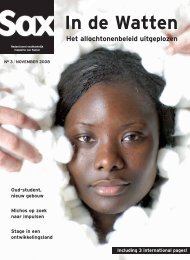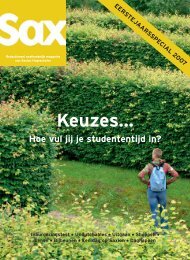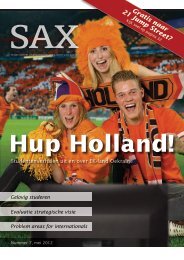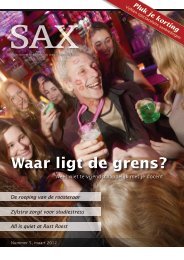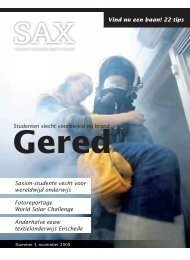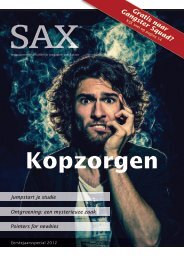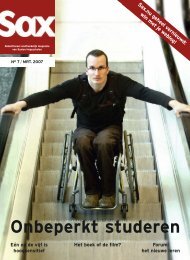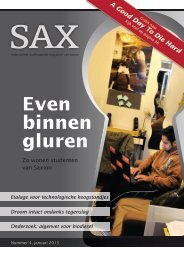Maatschappelijk verantwoord Saxion - Sax.nu
Maatschappelijk verantwoord Saxion - Sax.nu
Maatschappelijk verantwoord Saxion - Sax.nu
Create successful ePaper yourself
Turn your PDF publications into a flip-book with our unique Google optimized e-Paper software.
International<br />
In between art and nature<br />
What do the art of Vincent van Gogh and that of<br />
Pablo Picasso have in common with a natural park?<br />
All of these can be found in Otterlo in National Park<br />
The Hoge Veluwe, where the Kröller-Müller Museum<br />
is located. A worthwhile visit for those looking for a<br />
dose of art, architecture and nature.<br />
Photo: Cary Markerink<br />
Photo: Kröller-Müller Museum<br />
National Park The Hoge<br />
Veluwe is one of the<br />
Netherlands’ oldest and largest<br />
national parks. It consists<br />
of woodland, heath<br />
land, lakes and drift sand.<br />
You can walk undisturbed<br />
for hours. But do borrow<br />
one of the free 1700 white<br />
bikes, if you do not have<br />
more than a day to explore.<br />
They can be found at the<br />
different entrances to the<br />
park. You can also use the<br />
bicycles to get to the<br />
museum.<br />
The Kröller-Müller Museum<br />
is located at the centre of the<br />
National Park. Its collection<br />
consists of a large <strong>nu</strong>mber of works by painter Vincent van Gogh. It even<br />
offers works by George Seurat, Pablo Picasso and Piet Mondriaan. There is also<br />
a unique collection of sculptures in the sculpture garden.<br />
You can reach Otterlo by a bus service from Apeldoorn Central Station.<br />
Entrance fee for the park: seven euros. Entrance fee for the museum: another<br />
seven euros. Showing your <strong><strong>Sax</strong>ion</strong> pass/student card will allow you a fifty per<br />
cent discount on the museum fee. On rainy days the sculptures in the sculpture<br />
garden may be covered to avoid damage. On sunny days it may be that<br />
all the bicycles are in use. It is not possible to make reservations for the bikes.<br />
(WvT)<br />
What are knowledge centres?<br />
<strong><strong>Sax</strong>ion</strong> has six different knowledge centres. Each<br />
of them is specialized in a different area of the<br />
(international) society which they research and<br />
share their knowledge. Students too are doing<br />
research as part of their education.<br />
That <strong><strong>Sax</strong>ion</strong> doesn’t only educate and researches as well is common<br />
knowledge. But the <strong><strong>Sax</strong>ion</strong> knowledge centres are not well known<br />
among international students. These organizations help in finding answers<br />
for other organizations on questions they come across in daily life.<br />
This research is used to create new knowledge for the community and<br />
education at <strong><strong>Sax</strong>ion</strong>.<br />
At all knowledge centres ‘associate professors’ and students are involved<br />
in the research, although not many international students are. At the<br />
Knowledge Centre of Health, Welfare and Technology, however, there<br />
are eight Vietnamese master students of Advanced Nursing Practice.<br />
There is an international project in the Ukraine as well, although in this<br />
project there are no students involved at all. The master programme is<br />
part of the knowledge centre. (WvT)<br />
<strong><strong>Sax</strong>ion</strong> knowledge centres:<br />
• Knowledge Centre for Innovation in Education<br />
• Knowledge Centre for Environment<br />
• Knowledge Centre for Innovation and Entrepreneurship<br />
• Knowledge Centre for Health, Welfare and Technology<br />
• Knowledge Centre for Design and Technology<br />
• Knowledge Centre for Hospitality Business<br />
• These are not the official names for the knowledge centres.<br />
<strong><strong>Sax</strong>ion</strong> is currently designing these<br />
‘In my position I learn a lot’<br />
Many international students have a function in an<br />
international student association. One of them is<br />
Bhayu Prasetya, third-year student electrical<br />
engineering, from Indonesia. He is vice-chairman<br />
for culture and sport affairs of the Indonesian<br />
Student Association in Enschede.<br />
The association was founded in 1998,<br />
because of the great <strong>nu</strong>mber of Indonesian<br />
students in the area. This year there are<br />
almost 100 members. Prasetya: “We help<br />
Indonesian students in Enschede to adjust,<br />
to give them any important information<br />
before and after they arrive. We focus on a<br />
good community, relationship, and network<br />
among Indonesian students, even<br />
when they have finished the study and go<br />
back to Indonesia. We keep in touch by<br />
mail. For example, we organize cultural<br />
events to introduce our arts, culture, and<br />
customs. We have our own band, traditional<br />
dancers, and a football team. I chair<br />
the board when we want to organize a cultural<br />
or sport event. My position teaches<br />
me to manage people, to organize events<br />
and to create a network.” (MN)<br />
www.ppienschede.com<br />
Photo:Toma Tudor<br />
juni 2009<br />
33




